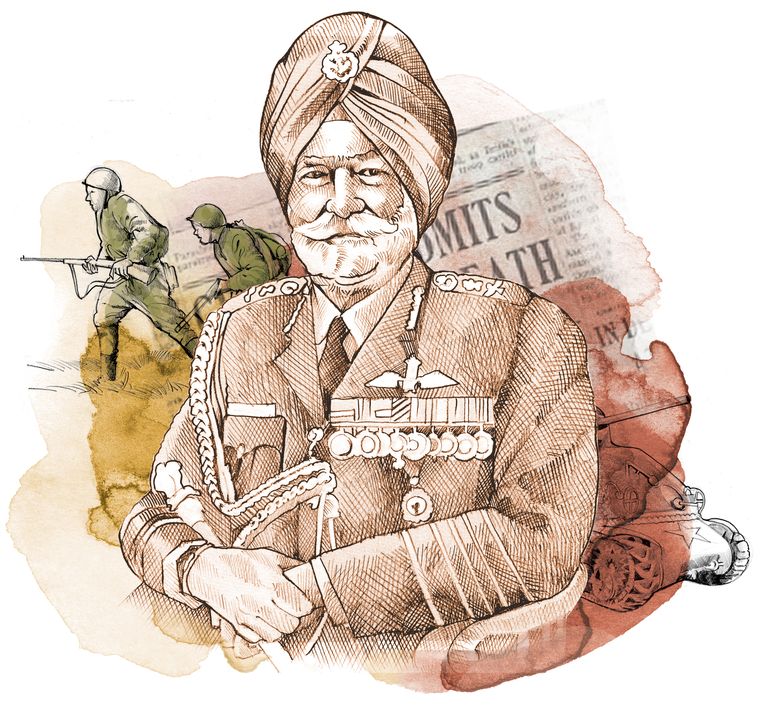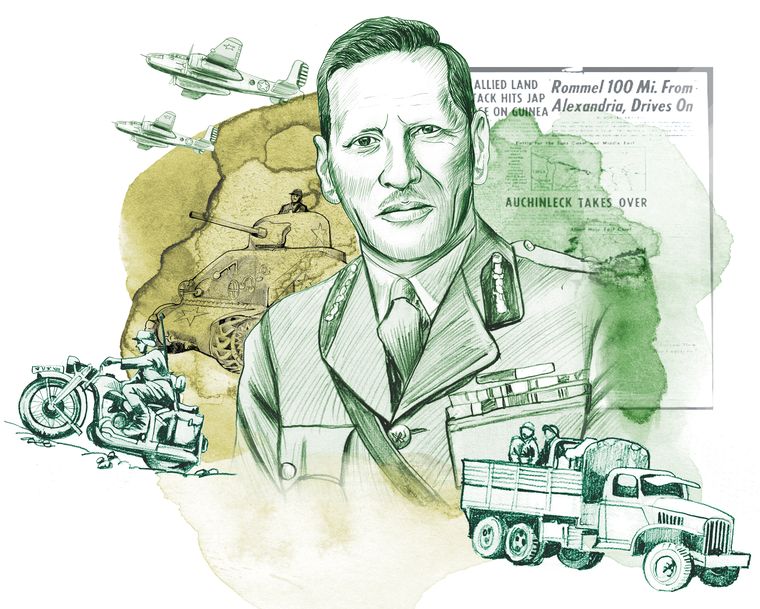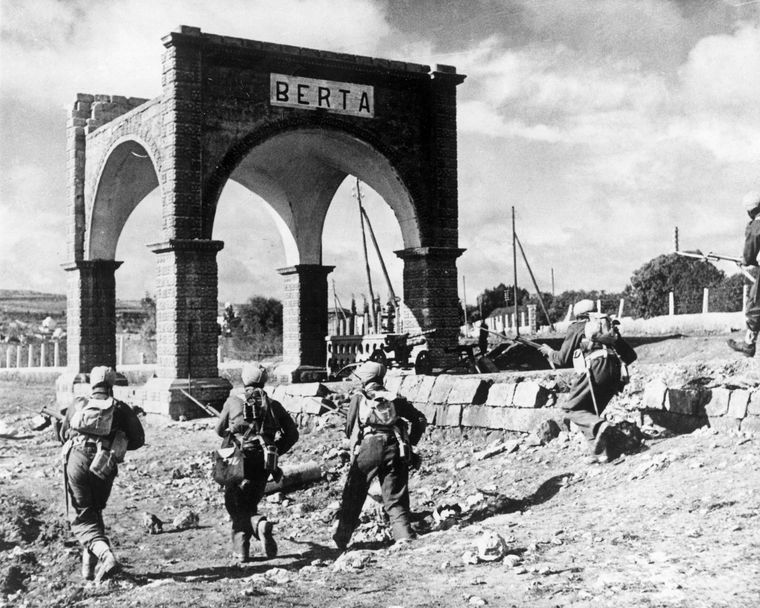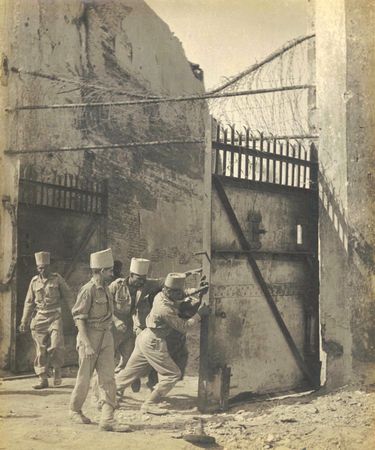THEY FOUGHT IN East Africa; they fought in North Africa. They fought in Iraq, Iran and Palestine, and in Italy, southern Europe, Borneo and the Philippines. They fought in Malaya; they fought in Singapore; they fought in Burma; they finally took a last stand at the gates of India, where they vowed not to surrender.
To paraphrase a famous Winston Churchill speech, they fought on the beaches, on the islands, on the landing grounds, in the streets, in the deserts, in the jungles, in the hills—they fought everywhere. Where they were not fighting, they were serving the men who were fighting—even on the frozen Russian front.
That was the story of the Indian Army in World War II. As military historian Rana Chhina says, they “fought against two of the finest armies of the world—the Germans and the Japanese—and proved [their] worth.”
When the war started, the Indian Army had less than two lakh men, including a few thousand British officers and men. When the war ended, they were 2.5 million, after losing 87,000 dead and 64,000 wounded; the largest voluntary army ever raised in the history of the world, as Churchill grudgingly conceded.
Here we present a broad picture of the major battles that the Indian Army fought. They won some, they lost some, but they fought all well.
★★NORTH AND EAST AFRICA★★
Defeating Italians; taking on Rommel
OPERATION COMPASS
This was the first large British operation in the war, and the Indian Army played a major role in it. British, Indian and other Commonwealth forces attacked Italy’s 10th Army under Marshal Rodolfo Graziani in western Egypt and Cyrenaica, the eastern province of Libya from December 1940 to February 1941.
The 4th Indian Division, commanded by Major General Noel Beresford-Peirse, joined the battle on December 9, 1940. In two days, they pushed the Italians out of their fortified positions, enabling the British to capture the Libyan ports and cut the enemy’s supply line. They captured 38,300 prisoners, 237 guns, 73 tanks and 1,000 vehicles.
OPERATION BATTLEAXE
This was a British attempt to raise the Siege of Tobruk and recapture eastern Cyrenaica from German and Italian forces. It was the first time that a major German force had to be on the defensive. The celebrated General Erwin Rommel launched his Afrika Korps in late March 1941 against the British Desert Force, which included the 3rd Indian Motor Brigade and the 11th and 18th Frontier Force Cavalry. They could not stop the Germans, but the motor brigade held ground at Meikili, and finally made breakthrough on April 8. This enabled an Australian division to entrench at Tobruk.In June, Archibald Wavell launched Battleaxe to drive out the Germans and Italians beyond Tobruk, but failed. The British and Indians fell back to Sidi Barrani. The failure led to the replacement of Wavell by Sir Claude Auchinleck.
OPERATION CRUSADER
Auchinleck was trying to bypass Rommel’s defences on the Egyptian-Libyan frontier and defeat the German armoured forces to relieve Tobruk, which was under siege. The 4th and 5th Indian Divisions and the 29th Indian infantry brigade formed part of the attacking force. On November 18, 1941, Auchinleck launched a surprise attack, but it lacked punch since he had dispersed his attack force. The attackers lost 530 tanks. On November 24, Rommel ordered the “dash to the wire”, causing chaos in the British rear echelons. The timely arrival of a New Zealand force saved the British and the Indians. By December, Rommel’s supply lines got thin. He narrowed his front and shortened his lines of communication. By mid-December, he withdrew to El Agheila.
FIRST BATTLE OF EL ALAMEIN
The British Eighth Army settled at El Alamein, only 106km from Alexandria port, from where their supplies were coming. Rommel, too, had his forces nearby, planning to capture Alexandria, and then Cairo, and ultimately the Suez Canal. But he was hampered by the fact that his supplies had to come from distant Tripoli in Libya. In July, Auchinleck’s Eighth Army launched six attacks employing, among others, the Indian 5th Division. Rommel resisted fiercely. As he suffered 13,000 casualties, including 3,000 Indians, Auchinleck decided to wait. But Churchill, who wanted immediate action, removed him and appointed Sir Harold Alexander as Middle East commander and William Gott as Eighth Army commander. Gott was killed when his aircraft was shot down. So Lt Gen Bernard Montgomery was appointed in his place. He took command on August 13.
SECOND BATTLE OF EL ALAMEIN
Rommel’s Afrika Korps launched a determined attack at Alam-el-Halfa on the night of August 30, 1942, but Montgomery resisted fiercely. On October 23, Montgomery launched an attack in which the 4th and 5th Indian Divisions played a major role. The Indian 5th Brigade broke through Rommel’s defences and captured El Alamein. By the end of November, the Allies took 30,000 prisoners.
The victory at El Alamein was the first big success against the Axis forces anywhere in the world. It eliminated the Axis threat to Egypt and the Suez Canal, which was Britain’s main supply route for oil from the Middle East and troops from India. The 4th Indian Division fought hard; the 10th Indian Division, too, joined at a later stage. Subedar Lal Bahadur Thapa and Company Havildar Major Chhelu Ram won Victoria Cross in these operations.
★★MIDDLE EAST★★
Securing oil for the war
ANGLO-IRAQI WAR
In 1940, a pro-German junta took power in Iraq, threatening Britain’s oil supplies and opening a route for Germans to invade Afghanistan and India. Since the Indian Army was even otherwise guarding the northwest against threat from Russia, it was asked to neutralise the threat. Gen Robert Cassels, commander-in-chief of India, who had successfully commanded a cavalry brigade in Iraq in World War I and helped end the Mesopotamian campaign, sent the newly formed 20th Indian Brigade under Brigadier D. Powell. Along with the British forces, they swiftly captured Basra and Baghdad, reoccupied Iraq and installed the pro-British Prince Abd al-Ilah.
SYRIA-LEBANON CAMPAIGN
In mid-May 1941, trouble arose in Syria, where French Vichy forces, which were friendly to Germany, captured the airfields. The 5th Indian Brigade joined the Free French forces and captured Damascus airfield in a bold night attack on June 21, 1941. Syria sought armistice in July 1941.
ANGLO-SOVIET INVASION OF IRAN
Iran ruler Reza Shah had good relations with Germany, and he threatened to cut oil supplies. Russia, which had just joined the war on the Allied side, panicked. The British moved the 8th Indian Division along with their own and Soviet forces in an Anglo-Soviet invasion. The 8th Indian Division attacked from the west while a Russian contingent attacked from the north. They installed a friendly regime and this ensured supplies to Russia. A new Persia and Iraq (PAI) Command was raised, consisting mostly of Indian units, to ensure the supplies to Russia.
★★EUROPE★★
Chasing Mussolini
ITALIAN CAMPAIGN AND THE BATTLE OF MONTE CASSINO
The victories in North Africa in 1941-42 enabled the Allies to plan an invasion of Italy from the south. The 8th Indian Division, which was with Mongomery’s Eighth Army in North Africa, captured Taranto port, which was the first bridgehead captured by the Allies on European soil. When the task of advancing to Rome was given to the British Fifth Army, the Indian 4th Division joined them.The division assaulted Cassino, but it proved costly. So the overall Middle East commander, Gen Harold Alexander, sent the 5th and 8th Armies to attack Liri Valley and force a way to Rome. The 8th Indian Division, too, joined the attack. They broke through the Gustav Line and chased the Germans into Rome. Soon the 10th Indian Division secured the north up to the Adriatic. As many as 4,720 Indians died in Italy; another 17,310 were wounded. Six Indians won the VC.
★★THE FAR EAST★★
A Dip in the Pacific
BATTLE OF HONG KONG (DECEMBER 8–25, 1941)
The day they bombed Pearl Harbour, the Japanese also attacked Britain’s crown colony of Hong Kong, which was garrisoned by British and Indian troops. The first attack was faced by the 2/14 Punjab. On December 8, 1941, their forward troops virtually wiped out a Japanese platoon.Despite being subjected to dive bombing and heavy mortar fire, 5/7 Rajputs held on to Devil’s Peak on the mainland until ordered to retreat to Hong Kong island. The Japanese followed them to the island, where they fought till the last man. The garrison held out for 18 days before being forced to surrender. Some were captured alive and murdered by the Japanese. Among the prisoners who survived were 5,072 British, 3,829 Indians and 1,689 Canadians.
★★SOUTHEAST ASIA★★
Enemy from the East
Malaya and Singapore
The Malayan and the subsequent Burma campaigns were the bloodiest battles for both the British and Indians. About 1,30,000 of the Allied troops were captured by the Japanese in Malaya alone, and 15,703 killed.
The British were caught off guard when Japan’s 25th Army, under Lt Gen Tomoyuki Yamashita, invaded Malaya and began bombing Singapore. The Indian III Corps, the 12th Brigade and a number of independent battalions resisted them, but were smashed in the battle of Jitra (December 11-13). The enemy swiftly advanced to Kota Bharu on the northeast coast of Malaya. As the British abandoned Penang, the local Indians felt betrayed, and many began to cooperate with the invading Japanese.
On January 11, 1942 Kuala Lumpur, too, fell to the Japanese. As the Japanese moved towards Singapore, less than 320km away, the Indian 11th Division resisted them bitterly in the battle of Kampar (December 30-January 2). But as the Japanese brought more forces by the sea, the Indians and the British retreated to Slim River. Two Indian brigades were wiped out in the battle of Slim River (January 6-8).
In the Battle of Muar, the 45th Indian Brigade was destroyed. The survivors grouped themselves into a Muar force and tried to keep off the Japanese while allowing the remnants of the Allied forces to escape from northern Malaya. When the wounded and bleeding force finally reached the bridge at Parit Sulong, they found it had been captured by the enemy. Every man was for himself then. They took to the jungles, swamps and rubber plantations. All but two of 135 troops were captured, tortured and killed. About 3,000 Allied troops were killed in the Battle of Muar. Of 4,000 men in the brigade, only 800 survived.On January 27, the remaining forces crossed over to Singapore. The Japanese invaded the island on February 7. The Allied force of about 80,000 was taken prisoner.
BATTLE OF BORNEO
As the Japanese threat loomed, the British sent the 2nd Battalion of the 15th Punjab and a gun battery from the Hong Kong-Singapore Royal Artillery to guard the airfield at Kuching, the capital of Sarawak. The Japanese attacked, killed 230 men of the battalion in one night, and captured the city on December 24, 1941. The defending force was disbanded, and they crossed over to Dutch Borneo, where they were placed under Dutch command. The men continued to resist the Japanese in the dense jungle of southern Borneo until April 1, 1942, when they finally surrendered.
★★ENEMY AT THE GATES★★
Burma campaign and Defence of India
On December 8, Japan invaded Malaya and, later, Burma. The 17th Indian Division fought and delayed the Japanese at Bilin River in February 1942. Outgunned, they retreated to the Sittang bridge. The enemy followed and in the ensuring Battle of Sittang Bridge, the division lost most of its guns and equipment.In April, the Japanese attacked the Yenangyaung oil fields, where the 48th Indian Brigade defended it with the British 1st Burma Division, inflicting heavy casualties. But the Japanese reinforced and struck. The badly bruised army retreated through the jungle, mostly without even transport, towards Manipur and were joined even by the Chinese.
In 1942 the Allies attacked Arakan with the Indian contingent trying to capture Mayu peninsula and Akyab Island, but failed. Then, Brigadier Orde Wingate raised the famous Chindits, who infiltrated through the Japanese front lines and marched deep into Burma, so as to cut the main north-south railway. They damaged communications of the Japanese in northern Burma, but most of them were killed or captured. All the same, the adventures of the Chindits became legendary and helped instil confidence in the Indian and British troops.By early 1944, the Indian XV Corps broke a Japanese counterstrike in the Arakan. As the XV Corps came under attack in the Battle of the Admin Box in February, the 5th Indian Division broke through the Ngakyedauk Pass and reinforced them. Both sides lost heavily, but that was the first major battle won against the Japanese and it was mainly by the Indian units.
BATTLES OF IMPHAL AND KOHIMA
Yet the Japanese pushed forward. William Slim correctly judged that they would now lunge forth towards India, and that is where the British would have to take a last stand.As the Japanese 15th Army under General Renya Mutaguchi and Subhas Bose’s Indian National Army crossed the Chindwin River on 8 March, Slim and Lt Gen Geoffry Scoones ordered a fighting retreat to Imphal and Kohima. Having blunted a Japanese attack on Arakan, Slim airlifted the entire 5th Indian Division to the Indian border.
The Japanese now struck Imphal. As the enemy rolled down the hill into the Imphal plain, IV Corps opened up while airplanes piloted by Arjan Singh and his buddies roared up into the skies and pounded them from the air, blunting the Japanese attack. By May, a counteroffensive was ordered.
Another Japanese division, under Lt Gen Kotoku Sato was pounding Kohima to capture it and advance to Dimapur. Lt Gen Montagu Stopford quickly reached there with his Indian XXXIII Corps and stopped Sato. The two brilliant defences finally stopped the Japanese march, which had never been stopped since the war began.
As Sato retreated, the troops of IV Corps and XXXIII Corps met at Milestone 109 on the Dimapur-Imphal road on June 22, signalling they shall not pass. That was the greatest defeat that the Japanese had suffered ever in history—60,000 dead and more than 1,00,000 wounded.As the enemy retreated, Slim ordered a pursuit. The 5th Indian Division advanced along the mountainous Tiddim road, captured Kalewa and crossed the Chindwin. Soon Mandalay and Rangoon were taken, and the Japanese were on the run.





